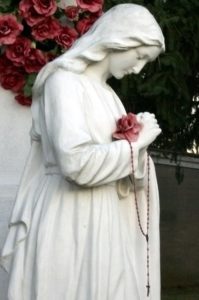“Never be afraid of loving the Blessed Virgin too much. You can never love her more than Jesus did.” – Saint Maximilian Kolbe
 “Miss LaTassa, during recess today I’d like you to stay in the classroom to work on our May altar.”
“Miss LaTassa, during recess today I’d like you to stay in the classroom to work on our May altar.”
It was the spring of 1973, and I was delighted to have been selected by Sr. Gemma to assemble the May altar for grade 4-1. Altar-building was a tradition at Our Lady of Mount Carmel School where, each year at the beginning of May, every classroom created its own little altar dedicated to the Blessed Mother.
So, when the recess bell rang that day, Sr. Gemma unlocked the supply closet at the back of the classroom and removed a box filled with plastic flowers, lace scraps, ribbon, two small tablecloths, pearlescent garland, vases, and a few old copies of House Beautiful to peruse for inspiration.
“Be sure to make Our Lady a lovely altar!” Sr. Gemma instructed with a smile before leaving me alone with the frippery and the magazines.
Sister had chosen me to design the May altar because I could draw well and, in the days before Hobby Lobby existed to meet every imaginable craft-goods need, I had a knack for making artsy things out of junk. Unfortunately, Sr. Gemma didn’t know that I was as plodding as I was creative (or, according to my plain-speaking mother, “as slow as molasses”).
How could Sister have known that, in handing me a heap of hodgepodge and a recess-period directive for a May altar, she may as well have given me all the pencil shavings in the classroom wastebasket and told me to spin gold from them before the fourth bell?
There was only one thing I could do: procrastinate. So I spent most of that recess period looking at pictures of home décor and designing achingly beautiful May altars in my head. I’d come across a photo of a rose topiary ball in one of the House Beautiful magazines, and had resolved to have a rose topiary ball for our classroom altar, even if its creation did require a 12” Styrofoam ball, one square yard of pink silk, a raft of toothpicks, and 150 hand-turned fabric roses.
A May altar thus embellished was a vision of perfection too wonderful to keep to myself, so I decided to give Sr. Gemma and my classmates a preview by drawing a plan for the altar on the blackboard. So as to be absolutely certain that no one would overlook the key element in the design proposal, I drew the topiary ball in contrasting pink chalk.
The end-of-recess bell rang, and Sr. Gemma and my classmates entered the classroom. Sister glanced at me, then at the blackboard, then again at me. She appeared confused. So did my classmates.
“Is that our May altar?” the students asked, pointing at the diagram on the blackboard.
“But where does the Mary statue go?”
“If that altar gets erased, can we make a REAL one?”
“How can we crown Mary if she isn’t there?”
“That’s the worst May altar we’ve ever had.”
Sr. Gemma settled the class down and then took me aside. It was apparent to Sister that her handpicked altar stylist had chalked herself into a corner.
“Celeste,” she said, her compassion evident in her use of my first name, rather than the usual “Miss LaTassa,” “how would you like to be the head of the May Altar Committee? I know two other girls who would be very happy to help. Since you are so creative, you could show them what to do.”
Sister’s idea was both diplomatic and brilliant, and the next morning, the May Altar Committee – Mary Ellen, Sue, and I – got down to business. Creating a rose topiary ball was out of the question, so we made do with a batch of colorful plastic roses that had once decorated the birthday cakes of unknown honorees. And later that afternoon, after Sister’s supply of ribbon, lace, and fake pearls had been fully depleted, we carefully placed the Blessed Mother statue on the bedecked May altar.
In the ensuing four weeks, the students of Grade 4-1 diligently kept the May altar tidy and its flower arrangements fresh. Each day they offered prayers before the homespun altar of Our Lady, whose statue had been ceremoniously crowned in early May. Every few days, I brought in fragrant blue irises from our small Bronx backyard and placed them in the vases provided by Sr. Gemma.
I can’t say that, in my childish willfulness, I didn’t at first wish that those ordinary irises would miraculously turn into petite pink roses studding a silk-wrapped sphere. Yet as I continued to take my turn placing flowers on the May altar, something happened. It dawned on me that Mary might actually like my irises better than the artificial roses in House Beautiful. After all, didn’t God Himself make them? And weren’t the irises’ soft ruffled petals the exact shade of Our Lady’s mantle?
I began to take pride in pleasing Our Lady with what I had ultimately decided were worthy flowers indeed. And if the floral mélange covering their classroom May altar gave any indication, then all the students of grade 4-1 were likewise delighting in gifting Our Lady with their simple bouquets. There is nothing, I’m sure, that could have given our Blessed Mother more joy.
Not even a perfect rose topiary.
“O Mary, may my heart never cease to love thee, and my tongue never cease to praise thee.” -Saint Bonaventure





0 Comments